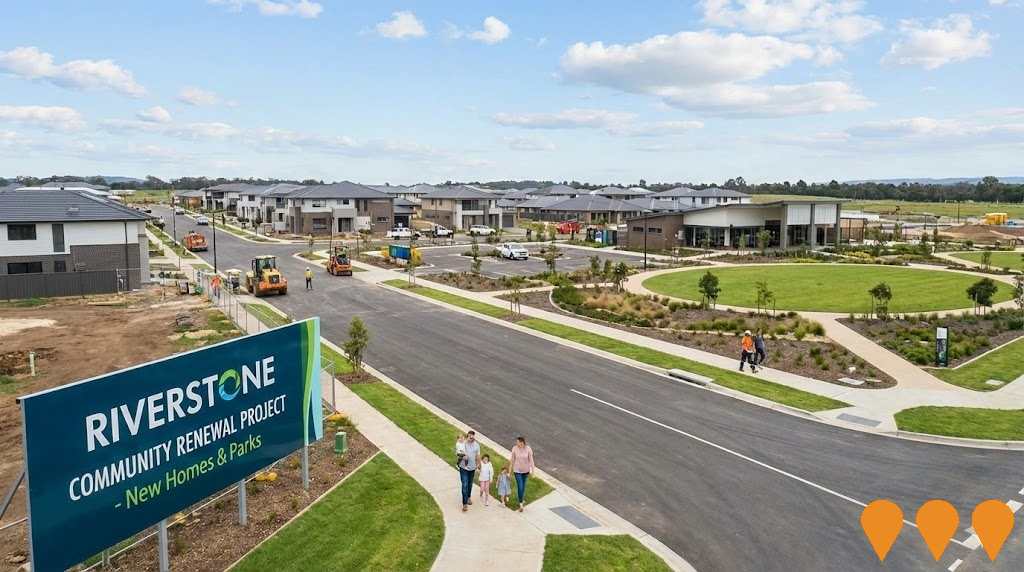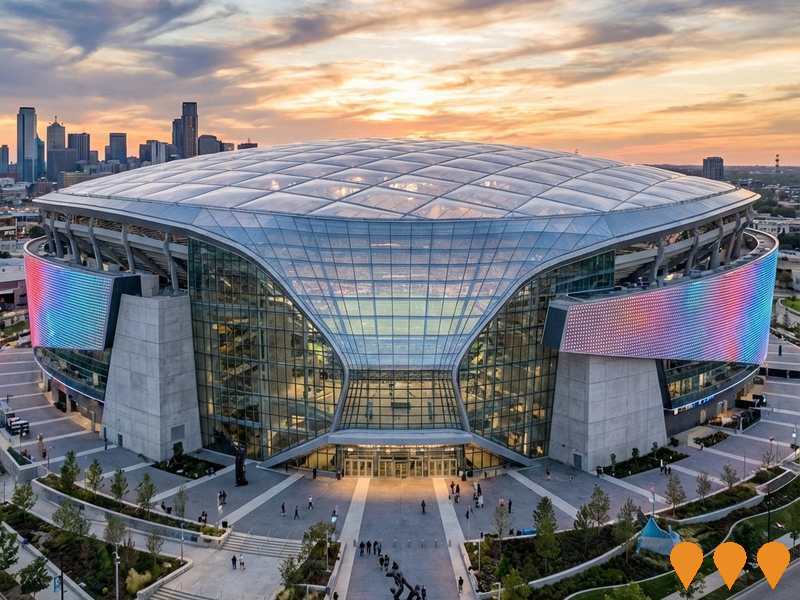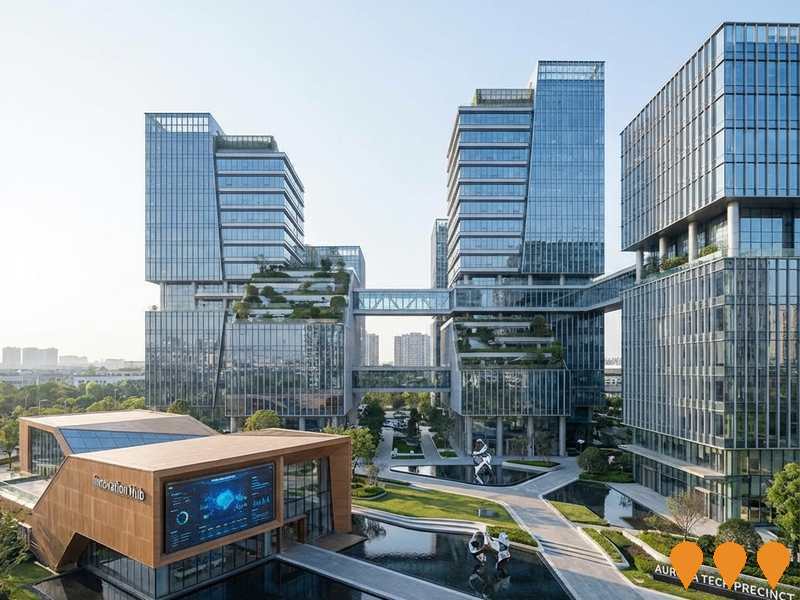Chart Color Schemes
est. as @ -- *
ABS ERP | -- people | --
2021 Census | -- people
Sales Activity
Curious about local property values? Filter the chart to assess the volume and appreciation (including resales) trends and regional comparisons, or scroll to the map below view this information at an individual property level.
Find a Recent Sale
Sales Detail
Population
An assessment of population growth drivers in Greenwich - Riverview reveals an overall ranking slightly below national averages considering recent, and medium term trends
Greenwich - Riverview's population, according to AreaSearch's analysis, is approximately 13,162 as of Aug 2025. This figure represents an increase of 234 people, a 1.8% rise since the 2021 Census which reported a population of 12,928. The change was inferred from the estimated resident population of 13,152 from the ABS as of June 2024 and an additional 7 validated new addresses since the Census date. This results in a population density ratio of 2,867 persons per square kilometer, placing it in the upper quartile relative to national locations assessed by AreaSearch. Overseas migration contributed approximately 78.8% of overall population gains during recent periods, driving primary growth for the area.
AreaSearch is adopting ABS/Geoscience Australia projections for each SA2 area, released in 2024 with a base year of 2022, and NSW State Government's SA2 level projections where applicable, released in 2022 with a base year of 2021. Growth rates by age group from these aggregations are applied to all areas for years 2032 to 2041. Future population trends indicate an increase just below the median of Australian statistical areas, with the area expected to grow by 1,614 persons to 2041 based on latest population numbers, representing a total increase of 12.2% over the 17 years.
Frequently Asked Questions - Population
Development
AreaSearch assessment of residential development activity positions Greenwich - Riverview among the top 25% of areas assessed nationwide
Greenwich Riverview has seen approximately 245 dwelling approvals per year over the past five financial years, totalling 1,225 homes. As of FY-26234 approvals have been recorded. This area has experienced a population decline in recent years, yet its development activity has remained relatively adequate, benefiting buyers. The average construction value for new properties is $541,000.
In terms of commercial development, there have been $6.7 million in approvals this financial year, indicating limited focus on commercial projects compared to residential ones. Compared to Greater Sydney, Greenwich Riverview has 196.0% more construction activity per person, offering buyers greater choice and reflecting strong developer confidence in the area. New developments primarily consist of townhouses or apartments (93.0%), with a smaller portion being detached houses (7.0%). This shift from the existing housing composition (currently 65.0% houses) indicates decreasing availability of developable sites and changing lifestyles that favour more affordable, compact living options. The area has approximately 69 people per dwelling approval, suggesting a relatively low-density market. Looking ahead to 2041, Greenwich Riverview is projected to grow by 1,604 residents. Based on current development patterns, new housing supply should meet demand adequately, providing good conditions for buyers and potentially facilitating population growth beyond current projections.
Looking ahead, Greenwich - Riverview is expected to grow by 1,604 residents through to 2041. Based on current development patterns, new housing supply should readily meet demand, offering good conditions for buyers and potentially facilitating population growth beyond current projections.
Frequently Asked Questions - Development
Infrastructure
Greenwich - Riverview has very high levels of nearby infrastructure activity, ranking in the top 10% nationally
Infrastructure changes significantly influence an area's performance. AreaSearch has identified 78 projects likely impacting the area. Notable ones include The Landmark Quarter St Leonards, Lane Cove Sport & Recreation Centre, St Leonards South Residential Precinct, and The Bellevue Greenwich. Below is a list of those most relevant.
Professional plan users can use the search below to filter and access additional projects.
INFRASTRUCTURE SEARCH
 Denotes AI-based impression for illustrative purposes only, not to be taken as definitive under any circumstances. Please follow links and conduct other investigations from the project's source for actual imagery. Developers and project owners wishing us to use original imagery please Contact Us and we will do so.
Denotes AI-based impression for illustrative purposes only, not to be taken as definitive under any circumstances. Please follow links and conduct other investigations from the project's source for actual imagery. Developers and project owners wishing us to use original imagery please Contact Us and we will do so.
Frequently Asked Questions - Infrastructure
Royal North Shore Hospital (RNSH) Campus Master Plan
A comprehensive 40-year strategic master plan (2023-2063) guiding the future expansion of the Royal North Shore Hospital precinct. The plan delineates zones for acute clinical services, research and education, and support facilities. Key components include the 'Herbert Street Precinct' (Lot 4B) redevelopment, managed by Property and Development NSW, which aims to deliver mixed-use commercial spaces and approximately 448 new homes, including affordable housing for health workers.

St Leonards Station Upgrade
Major upgrade to St Leonards Railway Station including new platforms, improved accessibility, enhanced passenger facilities, and integration with surrounding developments.

The Newlands St Leonards
Major residential development by Eterno (formerly Top Spring) featuring 330 apartments and terraces across five towers on 1.29-hectare site. Masterplanned community overlooking Newlands Park as part of St Leonards South precinct redevelopment with significant community contributions. Completion scheduled for September 2025.

The Landmark Quarter St Leonards
Luxury residential development by New Hope Group featuring three sculpted towers with 234 apartments, townhomes and penthouses designed by Rothelowman. Includes resort-style amenities, harbour views, and premium finishes. Located at 8 Marshall Avenue, St Leonards.

Park Avenue Residences St Leonards
Major residential development by JQZ at 26-50 Park Road, St Leonards. The existing buildings and trees will be demolished to make way for 4 new residential buildings with 306 apartments.

St Leonards South Multi-Building Development
$138 million development across 8,758sqm featuring 245 residential apartments in five buildings (3-9 storeys). Includes 2,411sqm communal open space with central 'green spine', swimming pool, and facilities.

St Leonards South Residential Precinct
Comprehensive urban renewal project delivering approximately 2,400 new dwellings with maximum building heights up to 65m (19 storeys). The precinct includes community facilities, childcare centres, 11,300m2 of new open space including new parks, retail spaces, improved transport connectivity, and rezoning from R2 Low Density to R4 High Density Residential. Developed under the St Leonards and Crows Nest Special Infrastructure Contribution. Construction has commenced on individual developments within the precinct.

Pacific Highway Corridor Upgrade (St Leonards Active Transport & Streetscape)
Program of walking, cycling and streetscape upgrades along the Pacific Highway through St Leonards to improve pedestrian crossings, provide safer cycling links and enhance public transport access and public domain. Works identified in the St Leonards and Crows Nest planning package include a new signalised pedestrian crossing at Pacific Highway/Oxley St, additional pedestrian crossings on nearby streets, and a future city-serving cycling corridor on/parallel to Pacific Highway supporting the new Crows Nest Metro station and St Leonards interchange.

Employment
AreaSearch analysis indicates Greenwich - Riverview maintains employment conditions that align with national benchmarks
Greenwich - Riverview has a highly educated workforce with a notable presence in the technology sector. Its unemployment rate is 3.4%.
As of June 2025, there are 7,568 residents employed, which is 0.8% below Greater Sydney's rate of 4.2%. Workforce participation stands at 66.5%, compared to Greater Sydney's 60.0%. Employment is concentrated in professional & technical, health care & social assistance, and finance & insurance sectors. Professional & technical employment is particularly high, at 1.7 times the regional average.
However, construction employment is limited at 4.5% compared to the regional average of 8.6%. The area appears to offer limited local employment opportunities, as indicated by the census working population vs resident population count. In the 12-month period ending June 2025, labour force decreased by 0.3%, while employment declined by 0.9%, causing unemployment to rise by 0.6 percentage points. This contrasts with Greater Sydney where employment rose by 2.6% and labour force grew by 2.9%. Jobs and Skills Australia's national employment forecasts from May 2025 project a 6.6% increase over five years and 13.7% over ten years nationally. Applying these projections to Greenwich - Riverview's employment mix suggests local growth of approximately 7.8% over five years and 15.5% over ten years, based on simple weighting extrapolation for illustrative purposes.
Frequently Asked Questions - Employment
Income
The economic profile demonstrates exceptional strength, placing the area among the top 10% nationally based on comprehensive AreaSearch income analysis
AreaSearch's latest postcode level ATO data for financial year 2022 shows Greenwich - Riverview had a median taxpayer income of $79,629 and an average of $122,798. Nationally, these figures place the area in the top percentile. In Greater Sydney, the median was $56,994 and the average was $80,856. Based on Wage Price Index growth of 12.61% since financial year 2022, estimates for September 2025 would be approximately $89,670 (median) and $138,283 (average). Census data indicates household, family, and personal incomes in Greenwich - Riverview rank highly nationally, between the 97th and 99th percentiles. The earnings profile shows that 47.1% of residents (6,199 people) earn over $4,000 per week, contrasting with the surrounding region where the $1,500 - $2,999 category predominates at 30.9%. This affluence is reflected in premium retail and service offerings. After housing costs, residents retain 88.4% of their income, indicating strong purchasing power. The area's SEIFA income ranking places it in the 10th decile.
Frequently Asked Questions - Income
Housing
Greenwich - Riverview displays a diverse mix of dwelling types, with above-average rates of outright home ownership
Greenwich - Riverview's dwelling structure, as per the latest Census, consisted of 65.4% houses and 34.5% other dwellings (semi-detached, apartments, 'other' dwellings). In comparison, Sydney metro had 41.1% houses and 58.9% other dwellings. Home ownership in Greenwich - Riverview was 40.4%, with mortgaged dwellings at 32.8% and rented ones at 26.8%. The median monthly mortgage repayment in the area was $3,500, higher than Sydney metro's average of $3,033. The median weekly rent figure was $600, compared to Sydney metro's $560. Nationally, Greenwich - Riverview's mortgage repayments were significantly higher at $1,863, and rents substantially above the national figure of $375.
Frequently Asked Questions - Housing
Household Composition
Greenwich - Riverview has a typical household mix, with a higher-than-average median household size
Family households comprise 76.1% of all households, including 39.1% couples with children, 29.1% couples without children, and 7.2% single parent families. Non-family households account for 23.9%, with lone person households at 20.6% and group households making up 3.3%. The median household size is 2.7 people, which is larger than the Greater Sydney average of 2.5.
Frequently Asked Questions - Households
Local Schools & Education
Educational achievement in Greenwich - Riverview places it within the top 10% nationally, reflecting strong academic performance and high qualification levels across the community
Greenwich Riverview's residents aged 15+ have a higher university qualification rate of 63.2% compared to Australia's 30.4% and NSW's 32.2%. Bachelor degrees are the most common at 38.8%, followed by postgraduate qualifications (20.5%) and graduate diplomas (3.9%). Vocational pathways account for 15.3%, including advanced diplomas (8.6%) and certificates (6.7%). Educational participation is high, with 31.6% of residents currently enrolled in formal education: secondary (9.5%), primary (9.4%), and tertiary (8.2%).
The area's three schools have a combined enrollment of 2,028 students, with an ICSEA score of 1165, indicating high educational performance. There are two primary and one secondary school serving distinct age groups, with school capacity exceeding typical residential needs at 15.4 places per 100 residents compared to the regional average of 11.9.
Frequently Asked Questions - Education
Schools Detail
Nearby Services & Amenities
Transport
Transport servicing is high compared to other areas nationally based on assessment of service frequency, route connectivity and accessibility
Greenwich-Riverview has 111 active public transport stops. These are a mix of ferry and bus services. There are 46 individual routes operating in total, providing 4,440 weekly passenger trips combined.
The average distance from residents to the nearest stop is 109 meters. On average, there are 634 trips per day across all routes, which equates to approximately 40 weekly trips per stop.
Frequently Asked Questions - Transport
Transport Stops Detail
Health
Greenwich - Riverview's residents boast exceedingly positive health performance metrics with very low prevalence of common health conditions across all age groups
Greenwich-Riverview demonstrates excellent health outcomes, with very low prevalence of common health conditions across all age groups. Approximately 79% (10,450 people) have private health cover, significantly higher than the national average of 55.3%.
The most prevalent medical conditions are asthma and arthritis, affecting 6.7% and 6.1% of residents respectively. 75.5% of residents declare no medical ailments, compared to 78.0% in Greater Sydney. The area has a higher proportion of seniors aged 65 and over, at 19.1% (2,520 people), compared to 15.7% in Greater Sydney. Health outcomes among seniors are strong, mirroring the general population's health profile.
Frequently Asked Questions - Health
Cultural Diversity
Greenwich - Riverview was found to be more culturally diverse than the vast majority of local markets in Australia, upon assessment of a range of language and cultural background related metrics
Greenwich-Riverview, compared to most local areas, had higher cultural diversity: 19.8% spoke a language other than English at home and 32.9% were born overseas. Christianity was the predominant religion, with 53.0%. Judaism was slightly overrepresented at 1.1%, compared to Greater Sydney's 1.0%.
For ancestry, the top groups were English (23.6%), Australian (20.2%), and Irish (10.6%). Some ethnic groups had notable differences: Hungarian at 0.5% vs regional 0.4%, French at 0.9% vs 0.7%, and Chinese at 8.4% vs 17.1%.
Frequently Asked Questions - Diversity
Age
Greenwich - Riverview's median age exceeds the national pattern
Greenwich-Riverview's median age is 41 years, significantly higher than Greater Sydney's average of 37 and slightly older than Australia's median of 38. Compared to Greater Sydney, the 15-24 cohort is notably over-represented at 14.9%, while the 25-34 group is under-represented at 11.0%. According to the 2021 Census, the 15-24 age group grew from 12.7% to 14.9%, and the 75-84 cohort increased from 5.7% to 6.8%. Conversely, the 5-14 cohort declined from 13.4% to 11.8%, and the 45-54 group decreased from 15.2% to 14.0%. By 2041, demographic modeling projects significant changes in Greenwich-Riverview's age profile. The 45-54 cohort is expected to grow by 39%, adding 726 residents to reach 2,569. Meanwhile, both the 0-4 and 5-14 age groups are projected to decrease in numbers.


